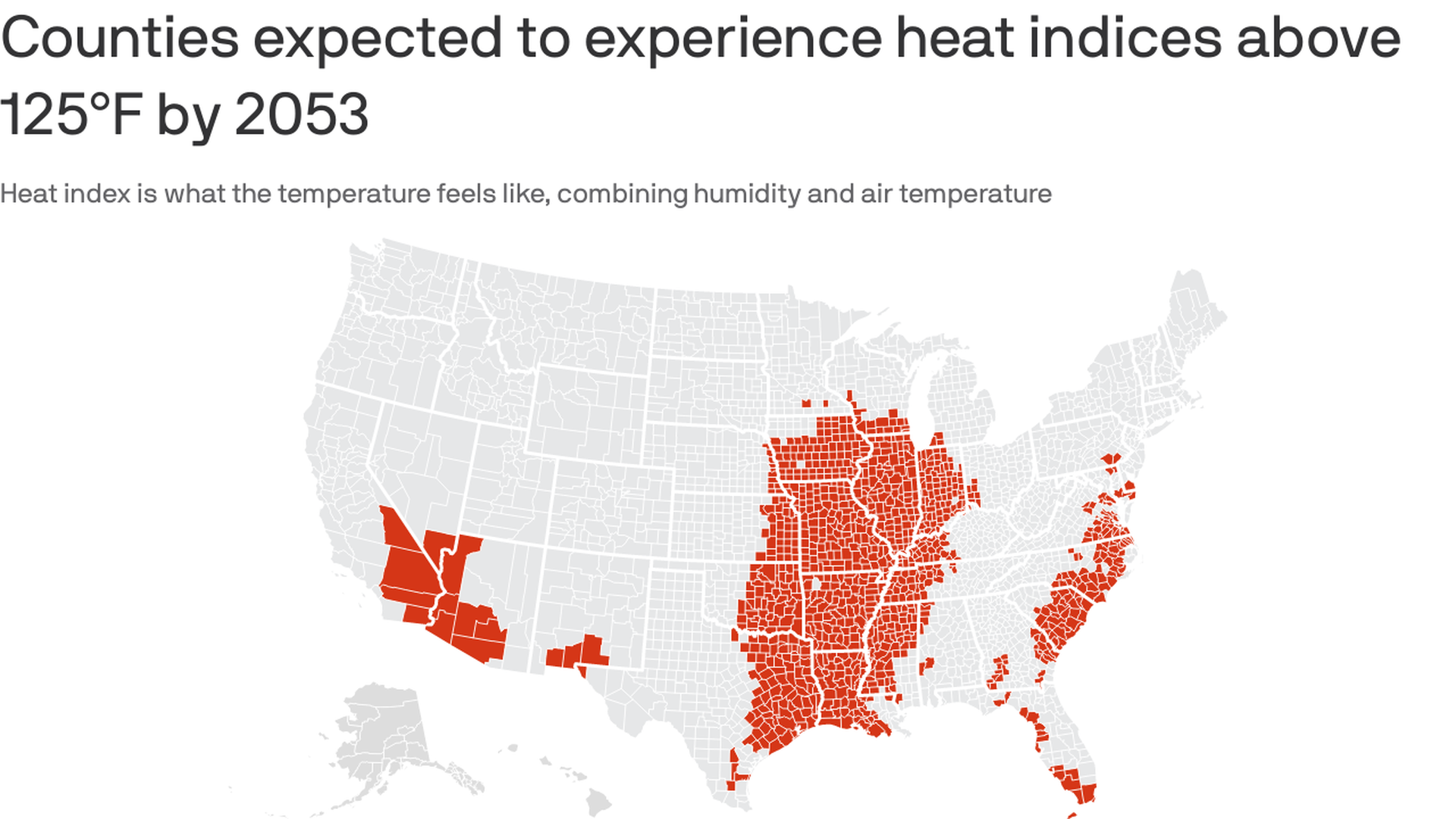Post by Atticus Pizzaballa on Aug 15, 2022 8:51:35 GMT -5
An "Extreme Heat Belt" will soon emerge in the U.S., study warns
Andrew Freedman
, author of Axios Generate

Note: Shaded counties are those that will, on average, have 0.5 days or more at or above a 125F° heat index in 2053; Data: First Street Foundation; Map: Axios Visuals
A new study reveals the emergence of an "extreme heat belt" from Texas to Illinois, where the heat index could reach 125°F at least one day a year by 2053.
The big picture: In just 30 years, climate change will cause the Lower 48 states to be a far hotter and more precarious place to be during the summer.
The findings come from a hyperlocal analysis of current and future extreme heat events published Monday by the nonprofit First Street Foundation.
The new report is unique for examining current and future heat risks down to the property level across the country, and joins similar risk analyses First Street has completed for flooding and wildfires.
As average temperatures increase due to human-driven greenhouse gas emissions, mainly from the burning of fossil fuels for energy, instances of extreme heat are forecast to escalate.
This report makes clear where households will be vulnerable to what would now be considered almost unheard-of heat indices, which show how the air feels from the combination of air temperature and relative humidity.
Threat Level: The report, which is based on First Street's peer reviewed heat model, shows that the number of Americans currently exposed to "extreme heat," defined as having a maximum heat index of greater than 125°F, is just 8 million.
However, due to the anticipated warming during the next three decades, that number is expected to balloon to 107 million people, an increase of 13 times over 13 years.
The developing "Extreme Heat Belt" forms a region of vulnerability from northern Texas to Illinois, and includes the cities of St. Louis, Kansas City, Memphis, Tulsa and Chicago.
By 2030, some coastal areas in the Southeast and Mid-Atlantic may also experience days with a heat index above 125°F, the report found.
Zoom in: The report shows a country that will have to grapple with the effects of increased heat exposure nearly everywhere, though there will be distinctions based on geography.
For example, the study finds that in 2053, the West will have the highest chance for long durations with "local hot days," which are days that exceed the temperatures typically experienced for a particular area.
The Gulf and Southeast will see the highest chances and longest duration of exposure to what are termed "dangerous days," with a heat index greater than 100°F, the report found.
Between the lines: The states likely to see the greatest growth in dangerous days are Texas, Louisiana, Arkansas, Missouri and Florida, First Street's analysis found.
The counties with the largest changes in dangerous days between 2023 and 2053 are mainly located in Florida, led by the populous areas of Miami-Dade, Broward and Palm Beach counties.
The report shows how the characteristics of heat waves may change in the near future. Many spots currently see more than 20 straight days with heat indices above 100°F. However by 2053, such streaks could be as many as 74 consecutive days, the report states.
The study also sheds light on cooling demand driven by the increasingly hot conditions, including cooling-driven increases in carbon emissions, which would aggravate warming further.
And Texas, Florida, California, Ohio and Missouri constitute the top 5 states with the biggest cooling demand-related uptick in CO2 emissions between now and 2053, the report shows.
Meanwhile... The U.S. is already seeing the clear fingerprints of human-caused global warming on extreme heat events. Last month, for example, the country's nighttime lows were the warmest on record for any month.
Unusually hot overnight temperatures during heat waves increase the risk to public health of heat-related illness.
In addition, the number of warm temperature records outnumbered the cold temperature records by a ratio of nearly eight-to-one.
What's next: Communities are innovating to reduce the impacts of extreme heat and put in place better heat action plans, among other climate resilience steps.
www.axios.com/2022/08/15/extreme-heat-belt-global-warming
Burn baby burn!



